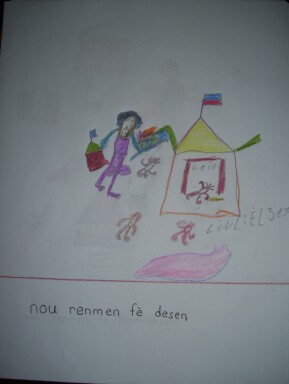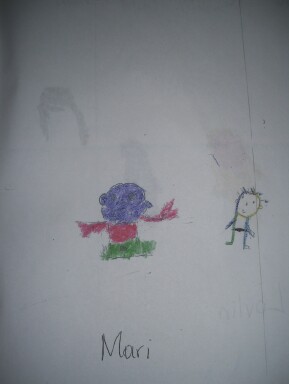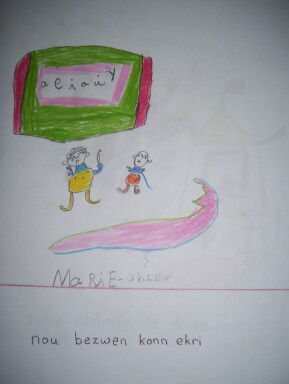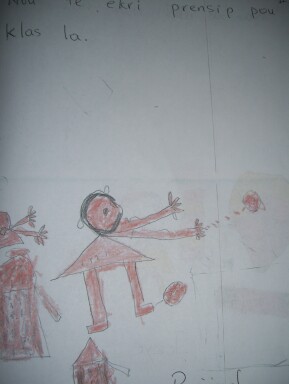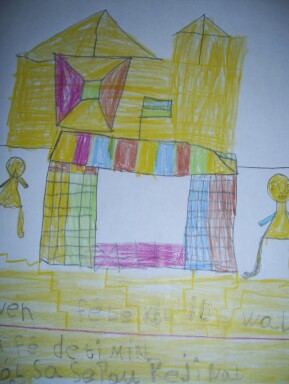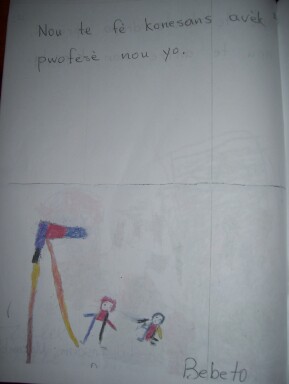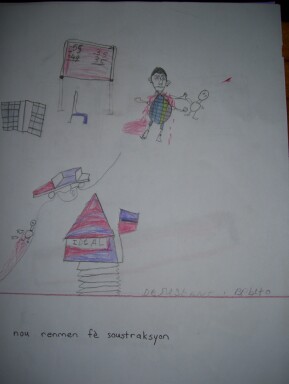Standard Haitian chemistry textbooks include an explanation of the electrolysis of water. Typically, a simple black-and-white diagram accompanies the explanation, showing a rectangular container in which two test tubes are suspended upside-down. Lines are drawn to represent two wires. Each wire has an end reaching into one of the test tubes. The other end is attached to something representing a battery. The accompanying description explains that the battery’s current separates the water into the oxygen and hydrogen it consists of. The equations that describe the steps in that process are also included. Students memorize the explanation and the equations.
Most students, however, lack these textbooks. Without the books, they are left to copy what a teacher writes on a blackboard or dictates. They may get a diagram, but not necessarily. Since their objective is merely to memorize the text, the diagram can seem only marginally relevant.
For more than a decade, the Matènwa Community Learning Center has been trying to do things differently, making education concrete and student-centered. Students are not asked to memorize, but are encouraged to understand. Students learn reading and writing by creating books in which they tell their stories and explain issues important to them. They learn math by working with blocks and other objects they can manipulate. And they study science by managing the same school garden that provides them with the meals they eat.
But though the Center has a middle school to go with the primary school, much less progress has been made in these more advanced classes.
There are good reasons for this. For one thing, the school’s co-founders – and Haitian and an American – are both primary school teachers. For another, primary school teachers in Haiti are much more stable than secondary school teachers. The former, much like their American counterparts, generally teach a single group of students all or almost all of their classes. They are, therefore, full-time in one school. Their secondary school colleagues, on the other hand, tend to specialize in one or two subjects, traveling from school to school, working perhaps just a few hours per week in each. Developing them as a faculty, integrating them into a particular school’s way of doing things, is much harder. The Learning Center has been able to spend years teaching its primary school faculty a particular approach to education that’s almost unique in Haiti, but has not had nearly as much time to devote to the middle school staff.
This year, the school decided to face this problem head-on. The most important change in this regard was to convince one of the most experienced primary school teachers to move up to take over the seventh-graders, teaching them almost all the subjects they learn. His name is Enel. I’ve written about his wife Millienne before, the school’s excellent second-grade teacher. Enel has been spending the last years teaching fourth, fifth, or sixth grade. This year, he’s been developing his own approach, having set it as his particular goal to help the kids prepare themselves for the more independent style of learning that secondary school requires. I’ve spoken several times with his students, and they seem happy with the way it’s working so far.
But they’ve also been looking for ways to make the upper school curriculum more concrete. So, for example, I spent a couple of days in January with the seventh-graders making citrus fruit batteries. And this week, in the midst of the days off that the school had for Kanaval, I worked with three of the teachers on the electrolysis of water. We did the experiment twice over the course of three days, and got somewhat different, though similar, results.
We started with an old plastic CD case, about eight inches tall. It was the kind of case that they sell stacks of blank CDs in. We filled it with saltwater. We then inverted two small pill bottles in it, filling them with water and taping them to the side of the CD case. We took two wires – actually two of the alligator-clip-tipped wires I brought into the country for the citrus battery experiment – and snaked each of them through the water so that its tip – that is, the alligator clip – would rise into one of the inverted pill bottles. Then we connected each of the wires to one of the poles of a battery. The battery we used was the size of a car battery, but is actually designed to be used as part of a solar electrical system.
Almost instantly, we saw bubbles start to accumulate on the alligator clip in one, but only one, of the inverted bottles. We continued to watch these bubbles for awhile, and then went off to do other things.
We returned several hours later to a striking sight. One of the pill bottles was about a third full of gas. The other had no gas in it at all. The alligator clip in that second bottle, however, was covered with a rust-colored film, and the water in the bottom inch or so of the CD case was the same rust color.
We immediately knew we had a lot to talk about. First, we had to consider why we were collecting gas in only one of the pill bottles. We were all taught that water is hydrogen and oxygen, and if we were breaking it apart, we needed to know why we were getting only one of the expected products.
What the textbooks don’t tell you is that it’s hard to actually produce the oxygen that theory calls for. That oxygen will tend instead to combine with most of the metals you might use for the wires. We weren’t sure what the alligator clips we made of, but whatever it was was reacting strongly with the oxygen that the reaction was supposed to be generating.
Second, we had to consider the identity of the gas we were collecting. How were we to convince ourselves that it was any different than the air we breath? We removed the pill bottle, and inserted a lighted match. We got a significant, though not violent, little “pop” as the hydrogen ignited: Nothing like that would happen if you stuck a match into a tube full of air.
We still wanted to see, however, whether we could get any oxygen. So we re-started the experiment with a different sort of wire. I knew that copper wire would react with the oxygen as well, but we hoped that, even if the oxidation of copper would use up some of the gas, some would nevertheless collect in the tube.
We were wrong. The hydrogen in this second experiment collected much more quickly than it did in the first experiment, but we still got no oxygen. What we did get was a layer of bright, aquamarine-colored dust suspended in the bottom quarter of the CD case. The color was stunningly different from the first color we got, and the reaction was so strong that the stripped end of the copper wire fell off and sunk to the bottom of the tank, stopping the electrolysis. We re-stripped the end of the wire twice, and found each stripped end at the bottom of the tank after only a few hours. When we removed the pill bottles from the water, and ignited the gas that we had collected in the one bottle, we got the same stunning little “pop” we had gotten the first time.
So the four of us talked about the results: Abner, Benaja, Robert, and I. We talked about the lack of oxygen, about the vigor of the hydrogen production, about how that production was tied to the availability of a metal on the end of the other wire to react with oxygen. More generally, we talked about how different it felt to see the reaction that they had only heard about. The conversation was wide-ranging.
But the most striking comment came from Abner, one of the school’s founding principals. He talked about how electrical appliances work when you plug them in. They each have a particular structure that is designed so that electricity can make them do their thing. He pointed out that seeing the electrolysis showed him, in a way he had never imagined, that water too must have a structure all its own. “Even water,” he concluded, “is not just simple stuff.”
It was the kind of statement that one could write down on a blackboard or into a book. And kids could learn to mouth those words. But Abner’s deducing as much from a partly dysfunctional experiment that he helped to undertake gave him a sense of the truth and an interest in it that no mere words or pictures could have offered.

